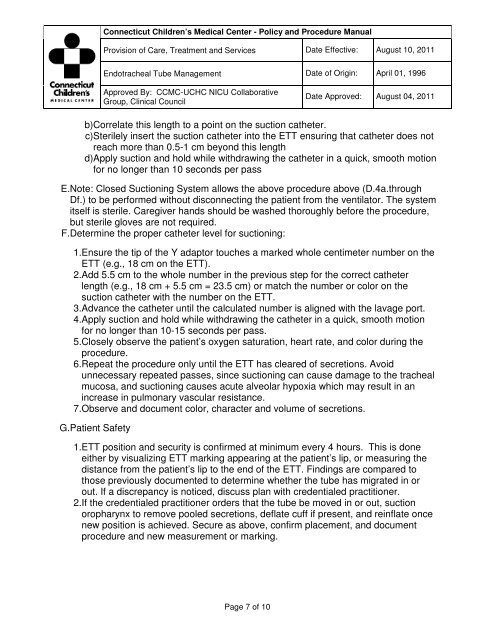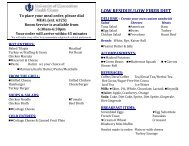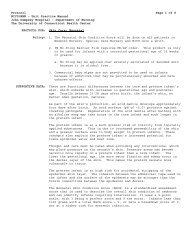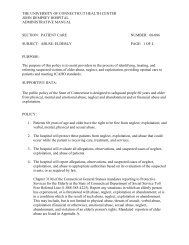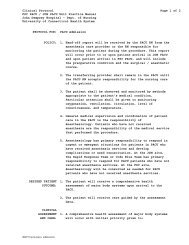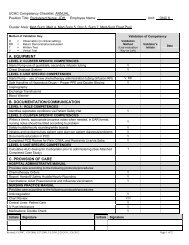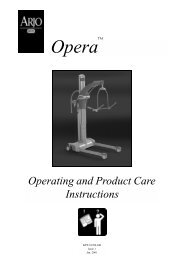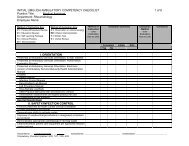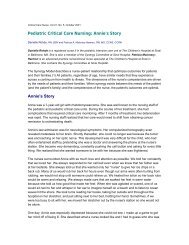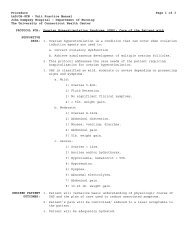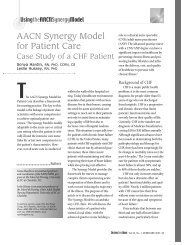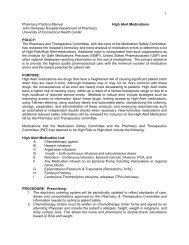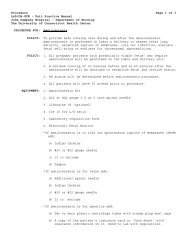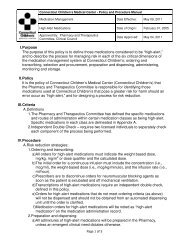Endotracheal Intubation
Endotracheal Intubation
Endotracheal Intubation
Create successful ePaper yourself
Turn your PDF publications into a flip-book with our unique Google optimized e-Paper software.
Connecticut Children’s Medical Center - Policy and Procedure ManualProvision of Care, Treatment and Services Date Effective: August 10, 2011<strong>Endotracheal</strong> Tube Management Date of Origin: April 01, 1996Approved By: CCMC-UCHC NICU CollaborativeGroup, Clinical CouncilDate Approved: August 04, 2011b)Correlate this length to a point on the suction catheter.c)Sterilely insert the suction catheter into the ETT ensuring that catheter does notreach more than 0.5-1 cm beyond this lengthd)Apply suction and hold while withdrawing the catheter in a quick, smooth motionfor no longer than 10 seconds per passE.Note: Closed Suctioning System allows the above procedure above (D.4a.throughDf.) to be performed without disconnecting the patient from the ventilator. The systemitself is sterile. Caregiver hands should be washed thoroughly before the procedure,but sterile gloves are not required.F.Determine the proper catheter level for suctioning:1.Ensure the tip of the Y adaptor touches a marked whole centimeter number on theETT (e.g., 18 cm on the ETT).2.Add 5.5 cm to the whole number in the previous step for the correct catheterlength (e.g., 18 cm + 5.5 cm = 23.5 cm) or match the number or color on thesuction catheter with the number on the ETT.3.Advance the catheter until the calculated number is aligned with the lavage port.4.Apply suction and hold while withdrawing the catheter in a quick, smooth motionfor no longer than 10-15 seconds per pass.5.Closely observe the patient’s oxygen saturation, heart rate, and color during theprocedure.6.Repeat the procedure only until the ETT has cleared of secretions. Avoidunnecessary repeated passes, since suctioning can cause damage to the trachealmucosa, and suctioning causes acute alveolar hypoxia which may result in anincrease in pulmonary vascular resistance.7.Observe and document color, character and volume of secretions.G.Patient Safety1.ETT position and security is confirmed at minimum every 4 hours. This is doneeither by visualizing ETT marking appearing at the patient’s lip, or measuring thedistance from the patient’s lip to the end of the ETT. Findings are compared tothose previously documented to determine whether the tube has migrated in orout. If a discrepancy is noticed, discuss plan with credentialed practitioner.2.If the credentialed practitioner orders that the tube be moved in or out, suctionoropharynx to remove pooled secretions, deflate cuff if present, and reinflate oncenew position is achieved. Secure as above, confirm placement, and documentprocedure and new measurement or marking.Page 7 of 10


